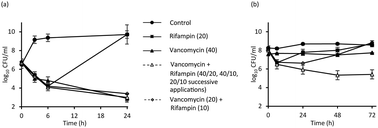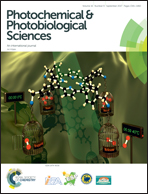How do fluorescence spectroscopy and multimodal fluorescence imaging help to dissect the enhanced efficiency of the vancomycin–rifampin combination against Staphylococcus aureus infections?†
Abstract
Staphylococcus aureus is one of the most frequent pathogens responsible for biofilm-associated infections. Among current clinical antibiotics, very few enable long-term successful treatment. Thus, it becomes necessary to better understand antibiotic failures and successes in treating infections in order to master the use of proper antibiotic therapies. In this context, we took benefit from a set of fluorescence spectroscopy and imaging methods, with the support of conventional microbiological tools to better understand the vancomycin–rifampin combination (in)efficiency against S. aureus biofilms. It was shown that both antibiotics interacted by forming a complex. This latter allowed a faster penetration of the drugs before dissociating from each other to interact with their respective biological targets. However, sufficiently high concentrations of free vancomycin should be maintained, either by increasing the vancomycin concentration or by applying repetitive doses of the two drugs, in order to eradicate rifampin-resistant mutants.



 Please wait while we load your content...
Please wait while we load your content...